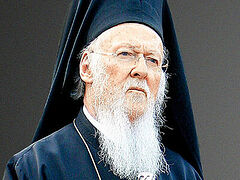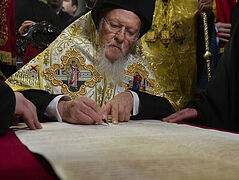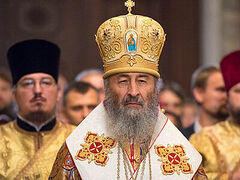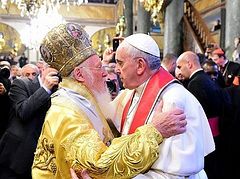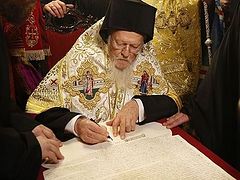We continue our analysis of the tomoi of autocephaly which have been granted by the Patriarchate of Constantinople. In Part 3 we discuss the recent tomos of the Orthodox Church of Ukraine, and state our conclusion.
The Most Holy Church of Ukraine (The Orthodox Church of Ukraine)
In 2019, the Church of Constantinople for the first time in history provided a tomos of autocephaly not just on foreign canonical territory, but to schismatics who did not have apostolic succession, and did this contrary to the opinion of most Orthodox peoples.
However, our task is to consider the content of the tomos, and not the context of its appearance.
The beginning of the document, as in the case of the Czech-Slovak Church, is devoted to the justification of the invasion of another’s canonical territory. Further, the document itself reads:
…our Modesty, along with our most reverend Metropolitans and most honorable beloved brothers and concelebrants in the Holy Spirit, in the imperative concern of the Great Church of Christ within the Orthodox world for healing long standing schisms and divisions in the local Churches, unanimously determine and declare that the entire Orthodox Church contained within the boundaries of the politically constituted and wholly independent State of Ukraine, with its sacred Metropolitan, Archdiocesan and Episcopal sees, its monasteries and parishes, as well as all the ecclesiastical institutions therein, operating under the Founder of the One, Holy, Catholic and Apostolic Church, our God-Man Lord and Savior Jesus Christ, shall hereafter exist as canonically a u t o c e p h a l o u s,1 independent and self-administered, having and recognizing as its First Hierarch in all church matters its presiding canonical Primate, who shall bear the title “His Beatitude Metropolitan of Kyiv and all Ukraine,” without any lawful addition or deletion to this title without permission from the Church of Constantinople. This Primate shall preside over the Holy Synod, annually comprised of Hierarchs invited by rotation and seniority from those serving within the geographical boundaries of Ukraine…
…Moreover, we recognize and declare this Autocephalous Church, established within the boundaries of the sovereign territory of Ukraine by means of this signed Patriarchal and Synodal Tomos, as our spiritual daughter, and recommend that all Orthodox Churches throughout the world acknowledge and commemorate it by the name “The Most Holy Church of Ukraine” …
…without being henceforth entitled to establish bishops or found extraterritorial altars in regions already lawfully dependent on the Ecumenical Throne, which bears canonical competence over the Diaspora, but instead restricting its proper jurisdiction within the territories of the State of Ukraine.
…while further preserving the right of all Hierarchs and other clergy to address petitions of appeal to the Ecumenical Patriarch, who bears the canonical responsibility of irrevocably passing judgment over matters related to bishops and other clergy in local Churches, in accordance with the sacred Canons 9 and 16 of the Fourth Ecumenical Council in Chalcedon.
In addition to the above, we declare that the Autocephalous Church in Ukraine knows as its head the most holy Apostolic and Patriarchal Ecumenical Throne, just as the rest of the Patriarchs and Primates also do, while having along with its other canonical obligations and responsibilities, as its foremost mission, the preservation of our Orthodox Faith inviolable as well as the canonical unity and communion with the Ecumenical Patriarchate and the other local Orthodox Churches unwavering…
…At the same time, the Orthodox Church in Ukraine, through its Primate or else the canonical locum tenens on the Throne of Kyiv, is obliged to participate in periodical Inter-Orthodox consultations on significant canonical, doctrinal and other issues, in accordance with the sacred custom long ago established by the Fathers…
…The First Hierarch, after being installed, must also immediately dispatch the necessary Irenic Letters concerning his establishment both to the Ecumenical Patriarch and the other Primates, just as he is also entitled to receive the same from these, while commencing his irenic journey as customary from the First-Throne Church of Constantinople, wherefrom it will likewise receive the Holy Chrism, as affirmation of its spiritual unity with the latter…
…In the case of major issues of ecclesiastical, doctrinal and canonical nature, His Beatitude the Metropolitan of Kiev and all Ukraine must, on behalf of the Holy Synod of his Church, address our most holy Patriarchal and Ecumenical Throne, seeking its authoritative opinion and conclusive support, while the prerogatives of the Ecumenical Throne over the Exarchate and Sacred Stavropegial institutions in Ukraine shall be preserved unmitigated…
…Consequently, on the basis of all the above and on the basis of these conditions, our Holy Great Church of Christ blesses and declares the Orthodox Church in Ukraine as Autocephalous… These things, then, are deemed and determined, joyfully proclaimed to you from the venerable Center of Orthodoxy, having been ratified in synod, whereas this Patriarchal and Synodal Tome is issued for permanent protection, being recorded and signed in the Code of the Great Church of Christ in Constantinople, delivered in an identical and accurate copy to His Beatitude Epifanios, the Primate of the Most Holy Church of Ukraine, and to His Excellency the President of Ukraine, Mr. Petro Poroshenko, for abiding verification and permanent confirmation.2
We will attempt to systematize the features and innovations of this tomos.
-
The “Patriarchal Ecumenical Throne” of Constantinople is declared as the head of the Church,3 and not the Lord Jesus Christ, who is merely called the “Founder” of the Church. This carries already not only canonical, but also critical dogmatic significance.
-
The title of the primate of the Church is not only fixed in the tomos, but also a ban on changing it without the consent of Constantinople is indicated. The reasons are obvious: to prevent attempts at forming a Ukrainian patriarchate.
-
Just like in the Czech Church, the principles of the Synod’s activity are strictly regulated.
-
The new “autocephalous church” is called a “daughter.” She is not addressed with the title “Sister.” But at the same time, the other Local Churches are called “sisters” of the new “Ukrainian autocephalic” church. Thus, the old terms are given a new meaning: there is the “Mother Church,” and the rest of the Churches are “daughters” to Constantinople but “sisters” amongst each other.
-
A ban is made on the presence or founding of parishes outside of Ukraine, and the resolution of the transfer and belonging of any and all existing Ukrainian diaspora parishes to the subordination of Constantinople, which allegedly possesses a monopoly on the Orthodox diaspora.
-
If in the tomos of the Czech-Slovak Church, the right of the Phanar hierarchs to interfere in its internal affairs is defined as being the right of being the court of highest instance, after church courts within the Czech-Slovak Church itself, then in this tomos, it is already indicated that any bishop or priest has the right to apply directly to Constantinople who has the right of “irrevocably passing judgment” in all situations. (The controversy of this allegedly canonical justification deserves separate examination outside the scope of this article.)
-
The tomos indicates that the throne of Constantinople is the “head” not only of the new “autocephalous church,” but that it is recognized as [head] by “the rest of the Patriarchs and Primates.” That is, the change from Christ being the Head of His Church, to Constantinople being the head, is not selectively applied to the “OCU,” but is declared for the entire Orthodox world.
-
The obligation (and not just the right) of the new autocephalous church is to participate in all meetings and other events of the Church of Constantinople written into law. Obviously, the unsuccessful experience of the Cretan Council, organized by Patriarch Bartholomew and ignored by many Local Churches, was taken into account.
-
The obligation of each new Primate of the OCU to begin their reign with a visit to Phanar written into law.
-
As in many other tomoi, the “OCU” requirement to receive chrism from the Patriarchate of Constantinople is written into law.
-
If previously the Phanar claimed a monopoly and supremacy in the moderation of external church relations of the new Churches to resolve “issues of ecclesiastical, dogmatic and canonical nature,” then, according to the new tomos, there is no sense in such interaction. Now the Ecumenical Throne will define all the necessary explanations itself, without inter-church discussion.
-
In addition to the new autocephaly itself, exarchates and stavropegia of the Church of Constantinople are being created on the territory of the OCU, whose rights are inviolable. That is, the canonical boundaries of the new structure are functional only unilaterally: The OCU cannot have foreign parishes; but on the OCU’s territory, the Patriarchate of Constantinople can have its own parishes, and its rights are inviolable and sovereign.
-
In the final part, it is additionally specified that autocephaly is granted precisely on these conditions. This clarification makes it possible to justify the abolition of autocephaly in the event of violation of these conditions.
Conclusions
Based on analysis of the gradual changes in the content of the tomoi of autocephaly issued by the Orthodox Church of Constantinople, we see the genesis of both its general ecclesiology and ideas about its own role and the role of other Local Churches.
As early as the sixteenth century, the increase in the number of Patriarchates was perceived organically (at least formally), and the decision was fixed in a conciliar manner, which we see from the autocephaly of the Russian Church.
The factor of conciliarity is partially present in the granting of autocephaly to the Church of Greece, in which, in addition to Constantinople, the Patriarch of Jerusalem takes part. But after that we no longer see the reflection of the principle of interchurch conciliarity in new tomoi.
In the nineteenth and twentieth centuries, some new autocephalous Churches, with considerable effort, acquire the status of Patriarchates, even if they historically had this status in the past. And others still have yet to receive it.
In general, the attitude of the Church of Constantinople to its role in the world and to other autocephalous Churches changed significantly as the Patriarch of Constantinople lost power in the Ottoman Empire. It was in the Ottoman Empire that the Patriarch of Constantinople possessed, in contrast to Byzantium, both formal and real political power, namely the status of an ethnarch, the head of Rum-millet4, who united all Orthodox Christians of the empire. Within the Ottoman Empire, many ancient autocephalous statuses were eliminated and incorporated into the Church of Constantinople, such as the Bulgarian or the Peć (Serbian) Patriarchates. But even the ancient Churches of Jerusalem, Antioch, Alexandria and Cyprus, which retained their autocephaly, were politically subordinate to the ethnarch (Constantinople). When the Sublime Porte lost control of these lands, this automatically deprived the influence and power of the Patriarchate of Constantinople. Facing new challenges and demands of national autocephaly, Constantinople was forced to look for ways to compensate for its losses. In part, this tendency manifests itself in the nineteenth century, which we can see in the formation of the autocephaly of the Greek Church.
This trend fully developed in the twentieth and twenty-first centuries, after the final collapse of the Ottoman Empire and the Constantinople Patriarchate’s loss of both political influence and parishioners within the Republic of Turkey, itself a result of the Greek pogroms (the genocide against the Pontic Greeks and other Hellenic peoples) and the expulsion of Greeks from the country.
This tendency found its expression both in the external expansion of the Phanar, which we are witnessing to this day and in an attempt to limit the autocephaly of new Churches and the preservation of its power and influence within their territories.
At the first attempt to curtail the autocephaly of the Church of Greece, Constantinople touched only on issues of chrism, the moderation of external relations and the principles of forming the Synod. Subsequently, using the example of the Serbian and Romanian Churches, we see almost full recognition of the new autocephalous Churches as equals (with the exception of granting them the status of Patriarchate, which was done later). Based on this, the experience of cutting back autocephaly in the tomos of the Church of Greece could be considered a [coincidental, outlying] non-systemic episode.
In the twentieth century, everything changed. It is obvious that attempts through various tomoi to minimize the actual independence of new autocephalous Churches, to subordinate them to the Phanar as much as possible, or, at least, to put them in a dependent position, are connected directly with the aforementioned loss of Constantinople’s position as ethnarch, since they all follow the liquidation of the Ottoman Empire. And they are, most likely, an attempt to compensate for those losses.
In fact, only the Bulgarian and Georgian Churches receive recognition of full-fledged autocephaly in the twentieth century from the Church of Constantinople. And in these situations, we are actually speaking about simply recognizing them after the event has taken place: both Churches had already been independent each for seventy-three years (an amazing coincidence of “the experience of non-recognition by the Phanar”!). In addition, both Churches were ancient Patriarchates, once deprived of autocephaly due to the vicissitudes of history. In these cases, the See of Constantinople claims only to moderate inter-church relations, and then in the case of the Georgian Church, in the form of a recommendation.
But the Phanar’s position on the autocephaly of new Churches looks completely different concerning the Polish, Albanian, Czech and even more so, the Ukrainian Churches. Here we are witnessing a much greater “cropping” of their powers and freedoms and the legal consolidation of mechanisms of influence on the inner life of these Churches.
In addition, there is a rethinking of the very role of the Patriarch of Constantinople and the Church of Constantinople. We can clearly see the metamorphosis of the “first among equals” into the “first without equals.” First, we see an unmistakable statement of the Orthodox teaching about Christ as the Head of the Church. Then the mention of this smoothly disappears from the documents, and as a result, in the Ukrainian tomos, we see in the place of the head of the Church, not Christ, but the See of Constantinople. The terminology reflecting interchurch relations also changes in the tomos: first, Constantinople is both the Sister to the rest of the Churches, and the Mother of the new autocephalous Churches, which are separated from her bosom, then she is only the Mother to them. And as a result, she is already only Mother to all Churches—without exception for Churches older than herself—and only the other Local Churches are Sisters to each other.
If in 1990, in the Georgian tomos given by Constantinople, instead of giving a “new autocephaly,” it simply recognizes the ancient autocephaly of the Georgian Church, which it received from the Church of Antioch; then in 2018, the speaker of the Phanar, Archbishop Job (Getcha) of Telmessos, said in an interview with the BBC:
“The Other [“new autocephalous”—Trans.] Churches existing in the Orthodox world today—starting from the Orthodox Church in Russia, continuing with the Churches in Greece, Serbia, Romania, Poland, Albania, Bulgaria, Georgia, Czechoslovakia—these are the new Churches—they were not confirmed by any of the Ecumenical Councils, it was Constantinople which gave them their status of existence.”
At first, Constantinople does not lay claim to the diaspora of the other Churches, but in 1922, [having lost most of its parishioners in the population exchange after the collapse of the Ottoman Empire—Trans.] the Synod of the Church of Constantinople declares the “obligatory and exclusive” subordination to itself of the entire Orthodox diaspora. And now we see the manifestation and realization of these claims in the tomoi that follow. This is a twentieth century innovation.
But in the twenty-first century, Constantinople goes even further and declares the right to create its own exarchates and stavropegia not only in the diaspora, but also on the territory of other Local Churches defined by it, which is evident from the Ukrainian tomos. So, gradually, the simply sonorous and honorable title “Ecumenical” [i.e. Universal] becomes a real territorial claim. “Orthodox Papism” takes on more and more obvious features.
Since the middle of the twentieth century, we see Constantinople’s claims in the tomoi expand to supreme judicial functions, and the increasingly active regulation of the internal model of government of the Local Churches, even down to determining the vestments of their first hierarchs.
Starting with the Ukrainian tomos, we see the inclusion of the requirement to participate in councils organized by Constantinople. Having suffered an epic failure in attempting to gather representatives of all Local Churches at the Council of Crete in 2016, the Phanar decided to consolidate its prerogative in tomos.
In fact, we see a gradual devaluation of the significance of autocephaly for the Local Church and its practical reduction to autonomy.
At the same time, it should be noted that in almost all tomoi, Constantinople declares that autocephaly is granted to the Local Church in question, since a corresponding separate independent state has appeared, arguing that this is the reason for the proclamation of autocephaly.
Here is how Archbishop Job (Getcha) speaks about it in the aforementioned interview:
“You must understand that in the Orthodox Church the administration of the Church always coincides with the administration of the state, the earthly—it is not me who invented this, and not Patriarch Bartholomew, it was said in the seventeenth canon of the Fourth Ecumenical Council. Therefore, in principle, when a new state appears, it is not an obligation, but it may ask for the organization of autocephaly for its Church.”
That said, we do not find any such statement in this canon—just as in principle, in none of the canons of all the Seven Ecumenical Councils, do we find such a statement in the context of autocephaly.
At the same time, we observe the selectivity of Constantinople’s approach to this issue: Where the political context allowed, in the twentieth century, Constantinople did not create any kind of autocephalous Churches at all, but rather established its own dioceses, at best, on the basis of autonomy: the Greek Orthodox Archdiocese of America (GOARCH), the Finnish Orthodox Church, Estonian Apostolic Orthodox Church, the new Greek dioceses, etc.
And thus, the Orthodox Church in America was never recognized by Constantinople, and the request of the Finnish Orthodox Church to grant it autocephaly has remained unanswered for forty years.
And only where the inter-ecclesiastical or political context exclusively requires autocephaly is it proclaimed by Constantinople. But at the same time, the real status of this type of “autocephaly” is often less independent than that of the autonomous status of some churches.
An example of this is the Ukrainian Orthodox Church, which has a self-governing status within the Moscow Patriarchate, and whose independence is much broader than that of the autocephalous “Orthodox Church of Ukraine.” The rights granted to the UOC by the ROC are much broader than the rights of the “OCU” defined by Phanar, which has been repeatedly written about already.
Another innovation of the tomoi, starting with the Czech one, is the fixation of “the conditions under which autocephaly is granted.” The right to cancel autocephaly is not spelled out directly in the documents, but, nevertheless, it has already been stated by representatives of Phanar:
“And, in principle, as some canonists believe, since these new autocephalous or new patriarchates were never confirmed by an Ecumenical Council, since they were created by the Ecumenical Patriarchate, then, at some point, if the Ecumenical Patriarchate deems it necessary, it can cancel this status.
So, who is claiming that the Ecumenical Patriarchate is losing some kind of power—on what basis?
On the basis of the canons, according to the teachings of the Orthodox Church, the Ecumenical Patriarchate has certain privileges. Whoever does not agree with this is actually splitting away from Orthodoxy.” (Archbishop Job (Getcha) in an interview with the BBC on November 2, 2018).
Now let’s compare the wording from the Ukrainian tomos (2019):
“In the case of major issues of ecclesiastical, doctrinal and canonical nature, His Beatitude the Metropolitan of Kiev and all Ukraine must, on behalf of the Holy Synod of his Church, address our most holy Patriarchal and Ecumenical Throne, seeking its authoritative opinion and conclusive support, while the prerogatives of the Ecumenical Throne over the Exarchate and Sacred Stavropegial institutions in Ukraine shall be preserved unmitigated.”5
…with a similar formulation from the Bulgarian tomos (1945):
“…on general ecclesiastical issues which require œcumenical (universal) discussion and study, let him defer to our Most Holy Patriarchal Ecumenical Throne, and ask and accept from it both its authoritative opinion and understanding, as well as the opinion and understanding of other Holy Sister Churches.”
…and with the wording of the previous Czech-Slovak tomos which came before the Ukrainian one (1998):
“With regard to global issues and ecclesiastical questions that go beyond the scope of possibilities of Local autocephalous Churches, His Beatitude the Archbishop of Prague and all the Czech Lands and Slovakia should turn to our Holy Patriarchal Ecumenical Throne, which is in communion with all Orthodox dioceses that rightly proclaim the word of truth. The Ecumenical Patriarchate will ask their Sister Churches for their opinions and positions.”
As we can see, in 2018, the Phanar already considered itself to be a sufficient and authoritative source to alone answer questions of “ecclesiastical, dogmatic and canonical character”, and there is no need for the opinion of the Sister Churches (daughter churches?), which had previously been sought. The conciliar mind of the Church is replaced by the sole decision of the Archbishop of New Rome.
We can recall another formulation, which is extremely close to this one in meaning:
“By virtue of his office, the Supreme Pontiff possesses infallibility in teaching when as the supreme pastor and teacher of all the Christian faithful, who strengthens his brothers and sisters in the faith, he proclaims by definitive act that a doctrine of faith or morals is to be held.”6
That is verbatim Canon 749 §1 of the Roman Catholic Church, which was confirmed in 1870 at the First Vatican Council, concerning the dogma of Papal Infallibility of the Roman pontiff. In the case of the Patriarchate of Constantinople, the function of the council was performed by the Synod of the Church of Constantinople, and the new dogma was reflected in the tomos.


